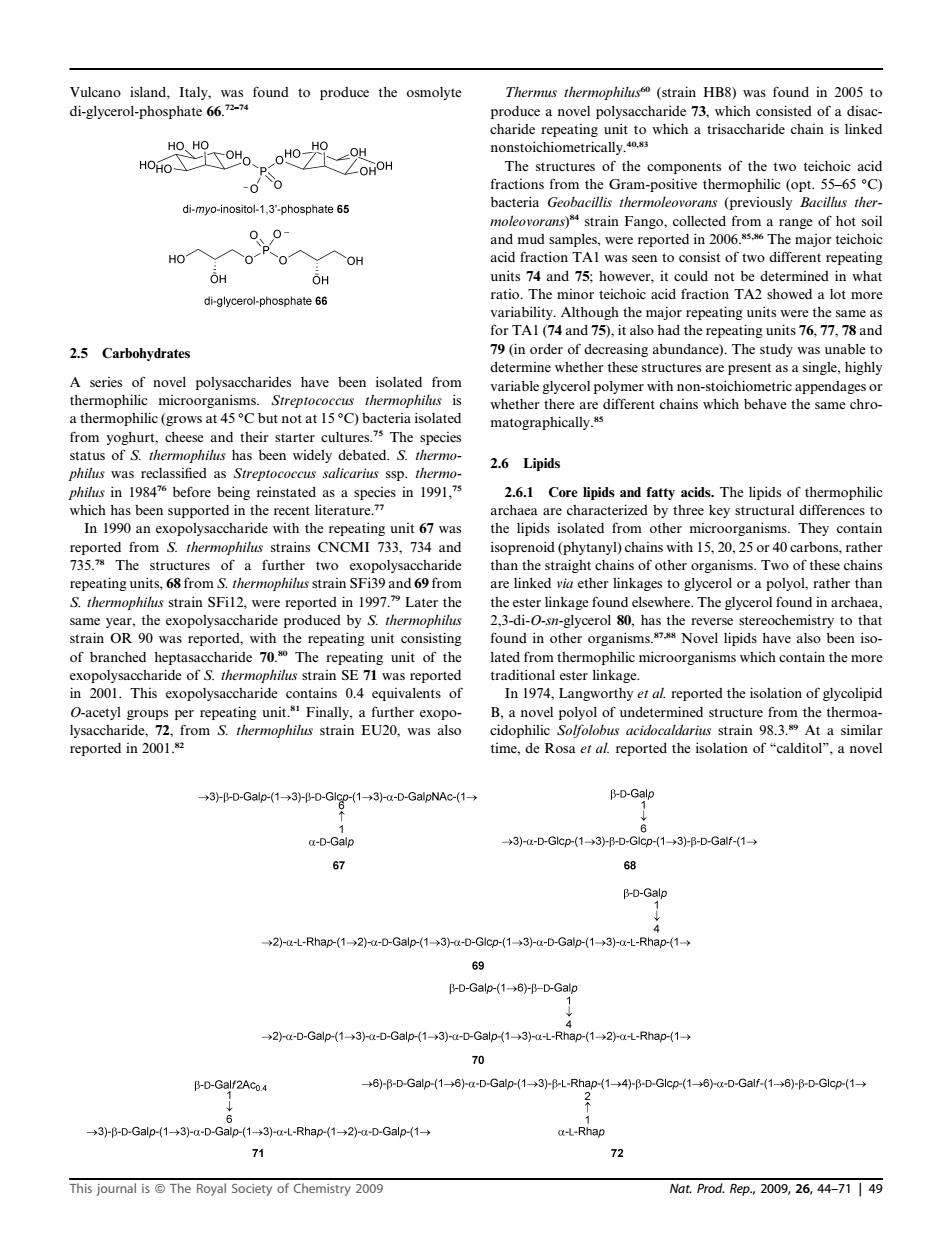正在加载图片...

的6 odtoodae them Thermus thermophils(strain HB8)was found in 2005 to The structures of the components of the acid di-myinphosphate65 00 Fango,collected from arange of hot so were reported in The major teichoi units 74 and 75:however.it could not be determined in what i-yoero-phoschate ratio.The minor teichoic acid fraction TA2 showed a lot more 2.5 Carbohydrates 79(in order of decreasing abundance).The study was unable to determine whether these structures are present as a single,highly A series of novel polysaccharides have been isolated from and thei 2.6 Lipids 2.6.1 Cor Th In 190 an exopolysaccharide with the repeating unit67was the lipids isolated from other microorganisms.They contain 0r40 areinked rid ether inka to glyeerol or a polyol.rather than S.thermophilus strain SFil2,were reported in 1997.Later the e produced byS sisti revers istry to tha d in oth of branched he 0.a cidophilic At a similar reported in 2001. time,de Rosa et al.reported the isolation of "calditol".a nove 30-Gap-(1→3Hp0-G1-→3a-D-GalpNAc-1- [-D-Galp 68 p-D-Galp →2ul-Rnep(1-→2a-0Gap(1→3)a-0-Gcp1→3-a-DGap(1-→3aL-R3p1→ 69 Bo.Galp-1-→6jp-DGa →2-t-D-Galp-(1→3)--D-Galp(1-3-D-Gp1+3-L-Rh8p1→2-aL-Rh8p(1→ 70 B-D-Gal/2Aco -6f-D-Gap-(1-6)a-D-Gap-(1-3)f-L-Rhap(1-4)-p-D-Glcp(1-8)a-D-Gaf-(1-8)-p-D-Glcp-(1- -3-B-D-Cap(1-+3)-a-D-Gdlp(1--3-at-Rhap(1-2a-0-Galp(1- ai-Rhap 71 This joumal isThe Royal Society of Chemistry 2009 Nat.Prod..Rep,2009.26,44-71|49Vulcano island, Italy, was found to produce the osmolyte di-glycerol-phosphate 66. 72–74 2.5 Carbohydrates A series of novel polysaccharides have been isolated from thermophilic microorganisms. Streptococcus thermophilus is a thermophilic (grows at 45 C but not at 15 C) bacteria isolated from yoghurt, cheese and their starter cultures.75 The species status of S. thermophilus has been widely debated. S. thermophilus was reclassified as Streptococcus salicarius ssp. thermophilus in 198476 before being reinstated as a species in 1991,75 which has been supported in the recent literature.77 In 1990 an exopolysaccharide with the repeating unit 67 was reported from S. thermophilus strains CNCMI 733, 734 and 735.78 The structures of a further two exopolysaccharide repeating units, 68 from S. thermophilus strain SFi39 and 69 from S. thermophilus strain SFi12, were reported in 1997.79 Later the same year, the exopolysaccharide produced by S. thermophilus strain OR 90 was reported, with the repeating unit consisting of branched heptasaccharide 70. 80 The repeating unit of the exopolysaccharide of S. thermophilus strain SE 71 was reported in 2001. This exopolysaccharide contains 0.4 equivalents of O-acetyl groups per repeating unit.81 Finally, a further exopolysaccharide, 72, from S. thermophilus strain EU20, was also reported in 2001.82 Thermus thermophilus60 (strain HB8) was found in 2005 to produce a novel polysaccharide 73, which consisted of a disaccharide repeating unit to which a trisaccharide chain is linked nonstoichiometrically.40,83 The structures of the components of the two teichoic acid fractions from the Gram-positive thermophilic (opt. 55–65 C) bacteria Geobacillis thermoleovorans (previously Bacillus thermoleovorans) 84 strain Fango, collected from a range of hot soil and mud samples, were reported in 2006.85,86 The major teichoic acid fraction TA1 was seen to consist of two different repeating units 74 and 75; however, it could not be determined in what ratio. The minor teichoic acid fraction TA2 showed a lot more variability. Although the major repeating units were the same as for TA1 (74 and 75), it also had the repeating units 76, 77, 78 and 79 (in order of decreasing abundance). The study was unable to determine whether these structures are present as a single, highly variable glycerol polymer with non-stoichiometric appendages or whether there are different chains which behave the same chromatographically.85 2.6 Lipids 2.6.1 Core lipids and fatty acids. The lipids of thermophilic archaea are characterized by three key structural differences to the lipids isolated from other microorganisms. They contain isoprenoid (phytanyl) chains with 15, 20, 25 or 40 carbons, rather than the straight chains of other organisms. Two of these chains are linked via ether linkages to glycerol or a polyol, rather than the ester linkage found elsewhere. The glycerol found in archaea, 2,3-di-O-sn-glycerol 80, has the reverse stereochemistry to that found in other organisms.87,88 Novel lipids have also been isolated from thermophilic microorganisms which contain the more traditional ester linkage. In 1974, Langworthy et al. reported the isolation of glycolipid B, a novel polyol of undetermined structure from the thermoacidophilic Solfolobus acidocaldarius strain 98.3.89 At a similar time, de Rosa et al. reported the isolation of ‘‘calditol’’, a novel This journal is ª The Royal Society of Chemistry 2009 Nat. Prod. Rep., 2009, 26, 44–71 | 49